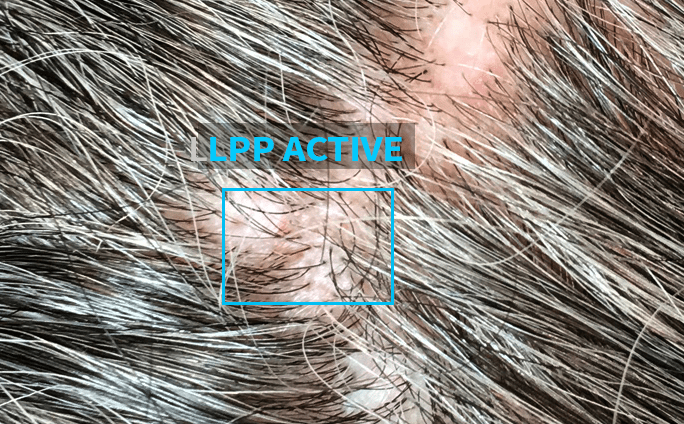I often have medical students, interns and resident doctors join me in my clinic at the Sunnybrook Medical Centre in Toronto, a teaching hospital which is part of the University of Toronto. I enjoy teaching others about hair loss – how to diagnose it and how to treat it – and how to know if the treatment is “working”.
For patients with scarring alopecias the goal of treatment is to stop the disease. The hair loss that the patient has experienced to date is permanent, and so the goal is not to grow back new hair. It therefore takes a bit more thinking to know if the treatment is working.
So what do you think?
I often ask the doctors “So, what do you think?” Take the patient in the photo on the right for example. She is referred regarding a diagnosis of scarring alopecia (a condition called lichen planopilaris) and she’s already on treatment (topical steroids and steroid injections). The key question I might be asked at this point by the patient is
Is the treatment helping and is the disease still active?
Often I might ask the doctors working with me:
So what do you think?
I don’t always expect the doctors to know the answers, but the question helps get the mind thinking. When I see this woman’s scalp – I think one thing – the treatment that was used so far is not working. At least not as well as we need to get it.
I can tell that this patient is itchy, even without asking. I can see that the hair follicles have some redness around them and one of them at the front has been repeatedly picked at. This is the hair follicle with the arrow attached. In fact, it’s been picked at to the point where it is now coming out of the scalp. The white ‘root sheath’ or blanket of cells can be seen wrapped around the hair follicle.
And when we ask the patient, we learn that she is in fact very itchy, and she’s been scratching her head often. She scratches and scratches and that’s why the hairs have been uprooted. There is also some burning in the scalp and a bit of tenderness in some areas. Morever, she feels she has lost more hair in the last 6 months.
Taken together – all these features suggest this patient has a scarring alopecia that is still “active.” She still has scalp symptoms and she’s still losing hair.
The following are questions I ask to determine if a scarring hair condition might still be “active”:
1) Is the scalp still itchy?
2) Is there burning in the scalp?
3) Is there pain in the scalp?
4) Has there been further hair loss since the last visit?
When a patient has ongoing activity it means they are at risk to lose even more hair in the future. In this case oral medications might be considered in addition to the topical steroids and injections, including such pills as doxycycline, hydroxychloroquine, mycophenolate mofetil or cyclosporine. Other strategies could also be used as well.

